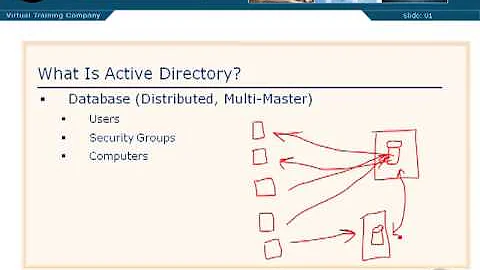What is the meaning of Active Directory?
Active Directory (AD) is a database and set of services that connect users with the network resources they need to get their work done. The database (or directory) contains critical information about your environment, including what users and computers there are and who's allowed to do what.
What is Active Directory and why is it used?
Active Directory stores information about objects on the network and makes this information easy for administrators and users to find and use. Active Directory uses a structured data store as the basis for a logical, hierarchical organization of directory information.

What does Active Directory mean in it?
Active Directory Definition
Active Directory is an important part of IT infrastructure. It can be used to manage devices, users, domains, and objects within a network. Organizations use Active Directory for its seamless identity and access management capabilities.
What are the 3 main functions of Active Directory?
The Top 3 major benefits of Active Directory Domain Services are:
- Centralized resources and security administration.
- Single logon for access to global resources.
- Simplified resource location.
What are the types of Active Directory?
What are the 4 types of Microsoft Active Directory?
- Active Directory (AD) Microsoft Active Directory (most often referred to as a domain controller) is the de facto directory system used today in most organizations. …
- Azure Active Directory (AAD) …
- Hybrid Azure AD (Hybrid AAD) …
- Azure Active Directory Domain Services (AAD DS)
What are the 5 roles of Active Directory?
Currently in Windows there are five FSMO roles:
- Schema master.
- Domain naming master.
- RID master.
- PDC emulator.
- Infrastructure master.
Where Is Active Directory used?
Active Directory (AD) is Microsoft's proprietary directory service. It runs on Windows Server and enables administrators to manage permissions and access to network resources. Active Directory stores data as objects. An object is a single element, such as a user, group, application or device such as a printer.
What are the two types of Active Directory?
Active Directory has two types of groups:
- Security groups: Use to assign permissions to shared resources.
- Distribution groups: Use to create email distribution lists.
What are 4 main components of Active Directory?
AD's main components, which you use to design the hierarchy and to optimize network traffic, are its logical structure and its physical structure. The logical structure, which simply organizes network resources, consists of OUs, domains, trees, and forests.
Who controls Active Directory?
Active Directory is managed by the operations team; which includes creation, deactivation, permission assignment to folders, printer management, etc.
What are the 4 most important benefits of Active Directory?
Benefits of Active Directory Domain Services
- You can customize how your data is organized to meet your companies needs.
- You can manage AD DS from any computer on the network, if necessary.
- AD DS provides built in replication and redundancy: if one Domain Controller (DC) fails, another DC picks up the load.
What are the 4 parts of an Active Directory?
So these are the stuff these are the four components uh we are we have in the logical components of the ad. Let's talk about the physical components of id here we have domain controllers domain
How do I access Active Directory?
Find Your Active Directory Search Base
- Select Start > Administrative Tools > Active Directory Users and Computers.
- In the Active Directory Users and Computers tree, find and select your domain name.
- Expand the tree to find the path through your Active Directory hierarchy.
What is an example of Active Directory?
An example of an Active Directory domain name would be “ad-internal.company.com,” where “ad-internal” is the name you are using for your internal AD domain, and “company.com” is the name of your external resources.
